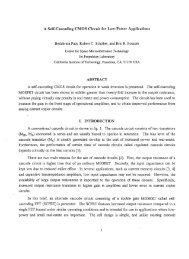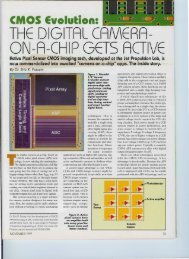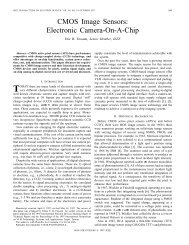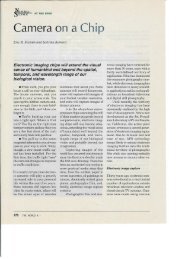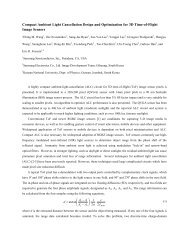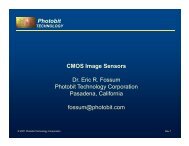Infrared readout electronics for space science sensors - Eric Fossum
Infrared readout electronics for space science sensors - Eric Fossum
Infrared readout electronics for space science sensors - Eric Fossum
Create successful ePaper yourself
Turn your PDF publications into a flip-book with our unique Google optimized e-Paper software.
FPAs are often used in several applications such as earth observing satellites in which the sensor is airborne and movingwith respect to the earth. We will attempt to describe state-of-the-art per<strong>for</strong>mance of both types of arrays used inscientific applications.Micro<strong>electronics</strong> feature size has steadily decreased over the past few decades enabling increasingly sophisticated unit cell<strong>electronics</strong> design. Simple unit cell <strong>electronics</strong>, such as the source-follower per detector (SFD) approach, continue to beattractive because of the achievable small pixel pitches and low power dissipation. More complex unit cell <strong>electronics</strong>utilizing high gain amplifiers are gaining in acceptance and provide excellent bias control, linearity and noiseper<strong>for</strong>mance. A comparison of the per<strong>for</strong>mance characteristics of different types of unit cell circuits is shown in table 1.We now attempt to summarize some of the more common approaches to unit cell design.3 . 1 Source-Follower Per Detector (SFD)The source follower per detector unit cell is shown in fig. 2. The unit cell consists of an integration capacitance (Cint), areset transistor (Mrst) operated as a switch, the source-follower transistor (M1), and one or more selection transistors.The integration capacitance may just be the detector capacitance and source-follower input capacitance. If A is the gain ofthe source-follower (A < 1), the photoelectron charge-to-voltage conversion is A(q/C) measured in volts per electron.The cell dissipates no active power during integration. The integration capacitance is reset to a reference voltage bypulsing the reset transistor. The photocurrent is then integrated on the capacitance during the integration period. As thesignal is integrated, the detector bias changes since the signal is integrated directly on the same node as the detector. Forlarge detector capacitances, the voltage-dependent integration capacitance of the detector can result in non-linear chargeto-voltageconversion limiting the usable dynamic range <strong>for</strong> scientific applications. Readout is achieved by selecting thecell and reading the output of the source-follower. The cell is susceptible to threshold voltage non-uni<strong>for</strong>mities leading tofixed-pattern noise (FPN), and to kTC noise unless correlated double sampling (CDS) is used. Since SFD consumes verysmall real estate, SFD <strong>readout</strong> is often designed to include a CDS circuit in the unit cell.rst'detVddselThe main source of white noise in the SFD unit cell is thesource-follower transistor itself. The input-referred whitenoise electrons is given by:kT Hintc + 217iflt 1R0 j/ N2\ —mt\ 1 whitewhere CL is the load capacitance which the source-follower isrequired to drive, Tint is the integration time, and thesaturation frequency (sat) is given by: fsat=l/(2rtRCjnt).VdetC Since SFD is used in applications where the detectori: bus resistance (R0) is extremely small, the detector white noisecontribution to the <strong>readout</strong> noise is negligible. If the loadcapacitance is much larger than the integration capacitance(usually the case, since it is dominated by the multiplexer buscapacitance), low noise per<strong>for</strong>mance is possible by allowingFig. 2. Schematic of source-follower per detector Cint to be small. However, SFD topology is particularlyunit cellsusceptible to 1/f noise. This is due to the fact that, unlikeother unit cell <strong>readout</strong> circuits, the time period <strong>for</strong> which the source-follower transistor is turned on during multiplexing islonger than the response time of the source-follower. The effect of this is to enhance the low frequency noise contribution,an effect that has been reported by various authors I lOJ.SFD has been used as the unit cell <strong>for</strong> several IRFPAs such as NICMOS3, JR FPAs to be used <strong>for</strong> MWIR and LWIRSIRTF applications as well as <strong>for</strong> MWIR ground-based telescopes. Cincinnati Electronics, Hughes and Rockwell havedemonstrated 256x256 SFD <strong>readout</strong>s [11,12,13]. The Hughes SFD <strong>readout</strong> is designed to operate both with InSb andSi:As impurity band conductor (IBC) detectors operating at sub 10K over a spectral range of 5-28 .tm. Since the Hughes266 I SPIE Vol. 2020 <strong>Infrared</strong> Technology XIX (1993)



